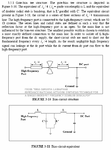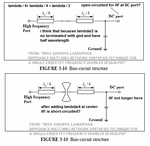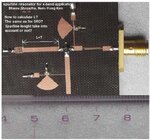Terminator3
Advanced Member level 3
I am learning example from book "RF Circuit Design Theory and Applications", second edition, Reinhold Ludwig, Gene Bogdanov p.476 "Microstrip design of GaAs FET oscillator".
On the page 471 there is oscillation condition formulas:
k<1 - stability factor must be less than unity.
Гin x Гs =1 (condition 1)
Гout x Гload =1 (condition 2)
on page 473 said, that if oscillation condition met either at input or output port, the circuit oscillates at both ports... Does it mean if i make matching network on drain, but gate will be not matched, there would be an oscillation? But how frequency is determined in this way? When both port are matched to Гin x Гs =1 and Гout x Гload =1 conditions, i can guess that because both ports electrical matching stub lengths related with frequency, then it is clear about frequency of oscillation. What if on of ports matched to other frequency.. This is my first question.

QUESTION N2
on the image we can see oscillator from www.ltcc.de
2.1. Why gate stab is a little longer, than half-wave? As i understand gate stub here is microstrip resonator. As it is longer, that means to me lower frequency of operation. And varactor can make it even much lower.
2.2. In question N1 source stub is used to increase instability, making k very small. That stub was < lambda/4 and short-circuited termination. But look here, source stub is longer, than quarter-wave. For short-circuit termination this source-stub will be a Capacitor, and only for oupen-circuit termination it would be a Inductance. So what purpose of that stub? Is it short-terminated or open-terminated?
"?" thin strip on gate looks as GND via.

Question N3
What is the length of gate microstrip when we using DRO? There is some position where DRO is placed, but stripline is always longer. I can't understand how to determine that length.
Question N4
here is the image:
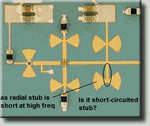
is it? Or not? I thing it is at High Freq (lambda/4 freq).
Question N5
again resonant gate stub problems, why length vary so strong? Why not lambda/4?
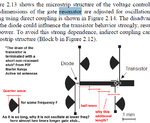
Thanks! More question pictures coming soon =)
On the page 471 there is oscillation condition formulas:
k<1 - stability factor must be less than unity.
Гin x Гs =1 (condition 1)
Гout x Гload =1 (condition 2)
on page 473 said, that if oscillation condition met either at input or output port, the circuit oscillates at both ports... Does it mean if i make matching network on drain, but gate will be not matched, there would be an oscillation? But how frequency is determined in this way? When both port are matched to Гin x Гs =1 and Гout x Гload =1 conditions, i can guess that because both ports electrical matching stub lengths related with frequency, then it is clear about frequency of oscillation. What if on of ports matched to other frequency.. This is my first question.

QUESTION N2
on the image we can see oscillator from www.ltcc.de
2.1. Why gate stab is a little longer, than half-wave? As i understand gate stub here is microstrip resonator. As it is longer, that means to me lower frequency of operation. And varactor can make it even much lower.
2.2. In question N1 source stub is used to increase instability, making k very small. That stub was < lambda/4 and short-circuited termination. But look here, source stub is longer, than quarter-wave. For short-circuit termination this source-stub will be a Capacitor, and only for oupen-circuit termination it would be a Inductance. So what purpose of that stub? Is it short-terminated or open-terminated?
"?" thin strip on gate looks as GND via.

Question N3
What is the length of gate microstrip when we using DRO? There is some position where DRO is placed, but stripline is always longer. I can't understand how to determine that length.
Question N4
here is the image:

is it? Or not? I thing it is at High Freq (lambda/4 freq).
Question N5
again resonant gate stub problems, why length vary so strong? Why not lambda/4?

Thanks! More question pictures coming soon =)
Last edited:
